FLAG
The history of the Libyan MiG-21 ‘Fishbed’ type
between 1980 and 2011
Early years and retraining of personnel in the early 1980s
The first Libyan MiG-21s arrived in the North African country in the late 1970s. According to old legends, previously Libya received MiG-21PF ‘Fishbed-D’ and MiG-21MF ‘Fishbed-J’ variants from the Soviet Union in the early 1970s, but this is not true. The misunderstanding may have arisen from the fact that between 1972 and 1973, the Egyptian Air Force stationed similar MiG-21 variants at Tobruk airport for training purposes. However, these were never owned by Libya.
So, the MiG-21bis 'Fishbed-L' and MiG-21UM 'Mongol-B' aircraft that arrived in the late 1970s were Libya's first MiG-21s! According to their serial numbers, the MiG-21bis aircraft were manufactured between 1977 and 1978, while the two-seater MiG-21UM aircraft were manufactured between 1978 and 1979. Their delivery from the Soviet Union to Libya, followed by their test flights and handover, usually took 8-15 months.
The end of the seventies was a period of intense development for the Libyan Air Force. Hundreds of new fighter aircraft: MiG-25 ‘Foxbats’, Mirage F-1s, Su-22s ‘Fitter’s, and MiG-23BN ‘Flogger-H’s arrived in the country, for which there were not enough Arab personnel. Therefore, the new MiG-21s were initially only stored, and it was not until 1980 that the training of Libyan personnel for the delta-wing type began. (According to old sources, North Koreans also flew the Libyan MiG-21s, but this was refuted by members of the early 1021st Air Squadron!)
The retraining of Libyan personnel on the MiG-21 began in 1980 at Misrata Airport. This is where the Libyan 1021st Air Squadron was formed. The MiG-21 retraining was carried out by Soviet personnel. At that time, the Libyan Air Force Academy operated here with Yugoslav, Soviet, Polish and Czechoslovakian instructors. Thus, the MiG-21s shared the Misrata airport with local Yugoslav-made Soko G-2AL Galeb, J-1L Jastreb training aircraft and Polish-made Mi-2 ‘Hoplite’ trainer helicopter. Due to heavy congestion, from 1981 onwards, the 1021st Squadron also used the new Al-Bombah airport, in parallel with Misrata.
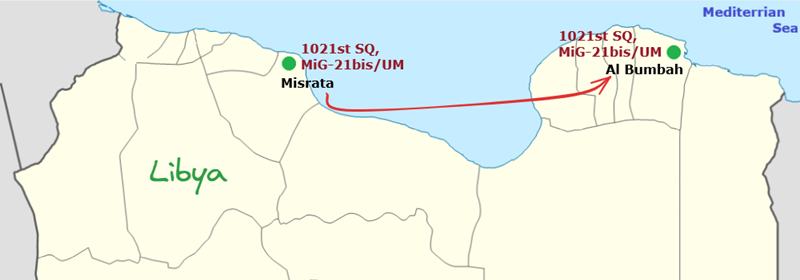

The first airfield of the Libyan MiG-21 in Misrata. On the left are two Galeb G-2AL training aircraft from the academy, followed by three Libyan MiG-21UM ‘Mongol-B’s and two MiG-21bis ‘Fishbed-L’s training aircraft from the 1021st Air Squadron in 1982.
Initially, some of the graduates of Misrata College in 1979 and 1980 were assigned to the 1021st Squadron. The squadron’s command staff was also young, they had previously flown Su-22s ‘Fitter’ or Mirage 5s for a few years and had been trained originaly in France. Several MiG-21s were lost during the retraining of Libyan personnel. Between 1980 and 1982, at least three young Libyan pilots died after taking off in MiG-21s from Misrata or Al-Bombah airfields.
In the early 1980s, the Libyan 1021st Squadron was assigned air defense, reconnaissance and advanced instructor roles on MiG-21bis and UM aircraft from the Al-Bombah airport (Martyr Ali Al-Rais air base). This airport opened in 1981 and was very similar to the Al-Watiya air base built by the French in the mid-1970s. Unfortunately, the base was located far from any major populated areas, so the personnel did not like it.
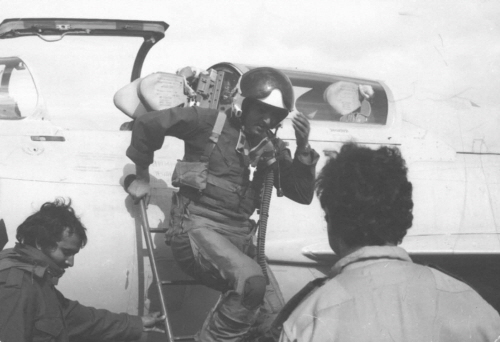
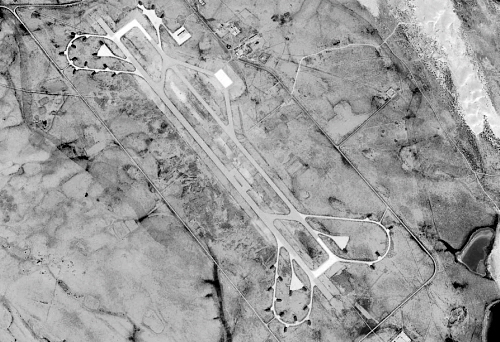
Exiting a Libyan MiG-21UM ‘Mongol-B’ aircraft at Al-Bombah Air Base in August 1981. The pilot is wearing an Anti-G Suit and Life Vest Belt because Al-Bombah Air Base is located on the Mediterranean coast. Photo: Mansour Taish
After the completion of the Al-Bombah (Martyr Ali Al-Rais) air base, it had a 3.5 km (11 600 ft) runway and 32 reinforced hardened shelter. Each shelter could store two MiG-21 or MiG-23 aircraft. Thus, the base could provide protection for 64 such aircraft! Image: Maxtar
The exact number of MiG-21bis/UM aircraft delivered to Libya by the Soviet Union remains unclear to this day. According to Western sources, 65 MiG-21bis/UMs arrived in Libya, of which only 25 remained by the 2000s, as can be proven.
-
so, either the 65-piece shipment is an exaggeration
-
or the MiG-21 suffered huge losses in Libya. In twenty years, it lost 60% of its fleet.
-
or possibly more likely, the rumor is true that in the early 1980s, Libya transferred some of its MiG-21bis aircraft to Syria. The latter has not yet been confirmed.
Combat training and combat missions between 1983 and 1994
from the Kufra airport
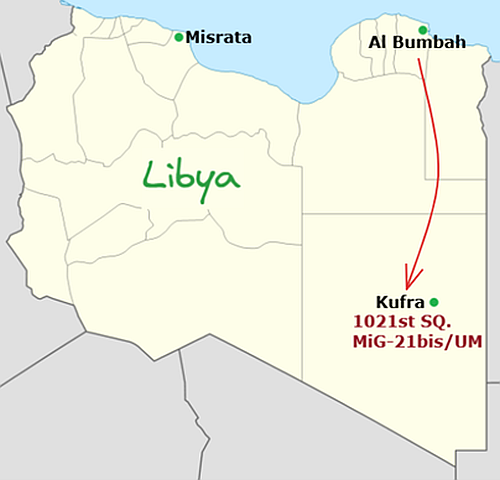
The 1021st Libyan Air Squadron was first forced out of Misrata Airport due to the large number of Soko G-2 Galeb and Mi-2 'Hoplite' training aircraft at the Air Force Academy. Then, in 1984, the MiG-21s were replaced with more modern MiG-23MFs ‘Flogger-B’ after the 1050th Squadron moved from Benina Airport to Al-Bombah Air Base. As a result, the 1021st Squadron moved to Kufra Air Base in south-eastern Libya between 1983 and 1984.
Here, the 1021st Air Squadron was tasked with combat training for young Arab pilots, for which the squadron used their MiG-21bis/UM aircraft.
Those young Arab pilots whom the Libyan Air Force planned to train for Soviet types, first flew L-39s at Libyan Air Force secondary schools (Mitiga, Sirte, and Barak airfields) or in Czechoslovakia and Soviet union. They then learned to fly MiG-21s in Czechoslovakia (MiG-21F-13 ‘Fishbed-C’) or the Soviet Union, Poland (MiG-21MF/bis ‘Fishbed-J/L’).
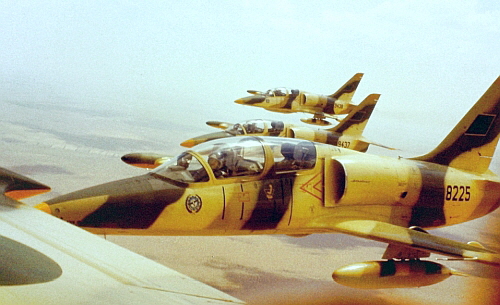
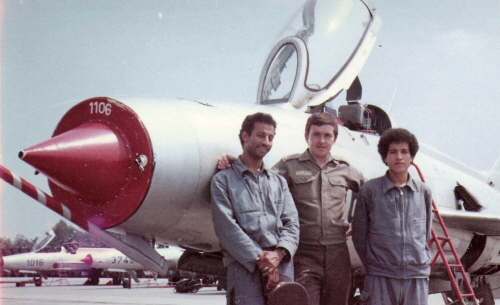
Libyan Aero Vodochody L-39ZO Albatros trainer aircrafts with Czechoslovakian trainer pilots over the Libyan desert.
Two Libyan student in Czechoslovakia with their Czech instructor in front of the Czechoslovakian Air Forces MiG-21F-13 (Aero Vodochody S-106) ‘Fishbed-C’ aircrafts in the early 80s. Photo: Mustafa Asherif
They were then assigned to the Libyan 1021st Air Squadron, where they received combat training from Syrian and Soviet instructors first at Al-Bombah, then at Kufra airport after the relocation. Among the Syrian trainers was, for example, Muhammed Faris Syrian astronaut too.
Here, the young Arab pilots flew an average of 100 hours on MiG-21bis/UM ‘Fishbed-L/Mongol-B’ advanced training aircraft before being assigned to their final type (MiG-25 'Foxbat', MiG-23 'Flogger' or Su-22 'Fitter').
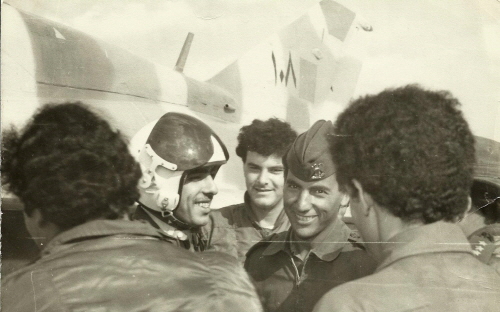
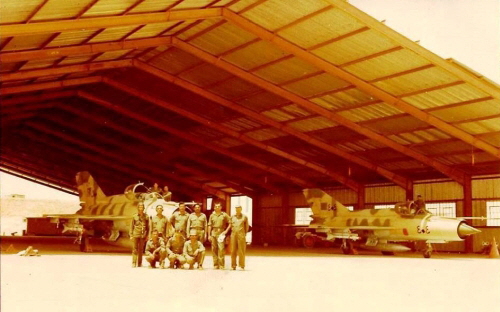
Young Arab pilots in front of a camouflaged Libyan MiG-21UM ‘Mongol-B’ B/N: 108.
Two MiG-21bis aircraft of the 1021st Air Squadron at Kufra airfield. Both MiGs (B/N: 500 and 404) are painted with typical factory sand and green camouflage. in the middle of the eighties.
After 600-800 flight hours, MiG-21bis ‘Fishbed-L’ aircraft require intermediate industrial overhaul. When the Libyan MiG-21s reached this number of hours, Federal Yugoslavia was chosen to perform this industrial-level maintenance in exchange for currency, due to its excellent relations with Libya.
The Yugoslav Aviation Technical Overhaul Factory at Zagreb specialized in the refurbishment of aircraft and engines and had extensive experience in maintaining its Yugoslav Air Force's MiG-21s.
The Libyan MiG-21bis aircraft were therefore transported to Yugoslavia in the mid-1980s. The overhaul work was carried out by the Yugoslav Aviation Technical Overhaul Depot at Zmaj, near Zagreb. During the work, the Libyan MiG-21bis aircraft were given a similar sand and green camouflage painting as their factory paintwork. And they continued to use Arab tactical numbers.
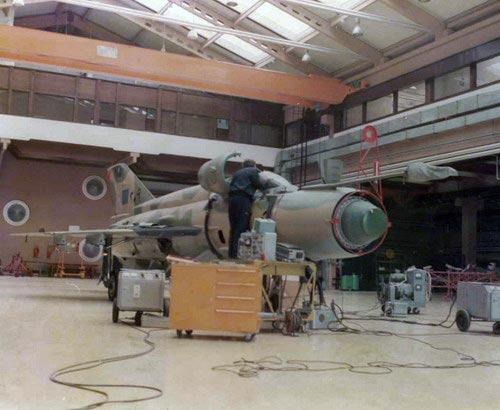
Libyan MiG-21bis ‘Fishbed-L’ aircraft B/N: 309 in the Yugoslav Aviation Technical Overhaul Depot at Zmaj in the 1980s
Although the main task of Libya's 1021st Air Squadron was to train young pilots for combat at the Kufra airport, in the second half of the 1980s, the squadron was repeatedly drawn into combat missions.
Gaddafi sought to extend Libyan influence into sub-Saharan Africa. One example of this was his military support for Burkina Faso. From 1983, Libya sent SIAI-Marchetti SF.260 training and light attack aircraft, followed by Mi-8T ‘Hip-C’ helicopters. Supplies were delivered by C-130H Hercules transport aircraft. Furthermore, in 1984, Libya allegedly provided Burkina Faso with eight MiG-21bis ‘Fishbed-L’ fighter aircraft and two MiG-21UM ‘Mongol-B’ training aircraft as military aid. However, there is no photographic evidence of this.
These aircraft belonged to the Libyan Arab Air Force and were operated by Libyan personnel. All MiG-21s were stationed at the Ouagadougou air base to support the Burkina Faso Air Force, but Burkina Faso personnel were not trained to operate them. Before the brief Agacher War between Burkina Faso and Mali in December 1985, the Libyan MiG-21s were withdrawn from Burkina Faso.
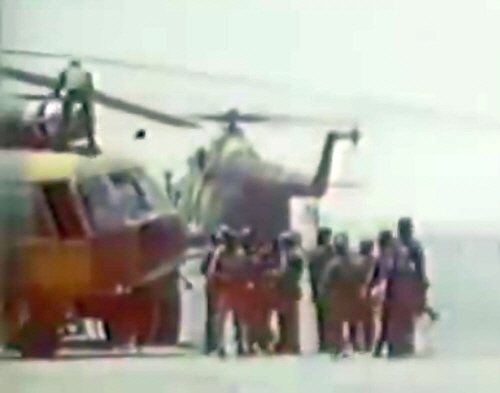
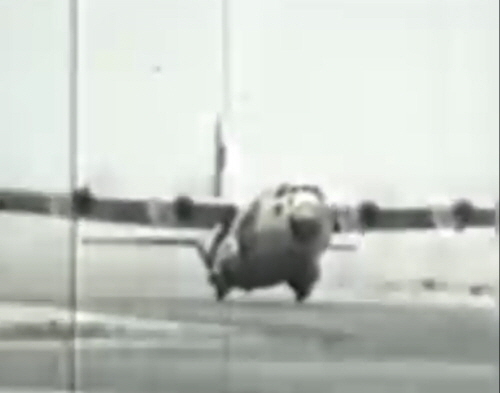
Libyan Air Force Mi-8 helicopters and C-130 transport aircraft during their mission in Burkina Faso.
The next time they came close to Libyan MiG-21bis ‘Fishbed-L’ combat operations was in 1987. In the Toyota War, Chadian forces advanced from south to north. They recaptured northern Chad and even the Aouzou Strip. They occupied Ouadi Doum airport, where they captured SF.260s, L-39s, and Mi-24s. The Libyan expeditionary army disintegrated and fled north.
In September 1987, Chadian forces even penetrated southern Libya! They attacked and captured the Maaten al-Sarra airbase. From there, on September 5, Libyan Su-22M bombers and MiG-23MLD fighters fled to Kufra airport, where the 1021st air squadron of MiG-21bis ‘Fishbed-L’s was stationed.
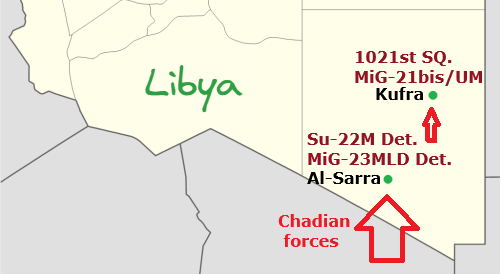
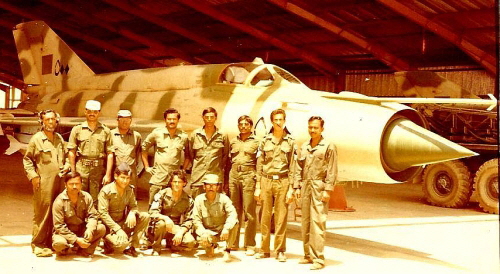
The events in southern Libya on September 5, 1987 during the Toyota War
Libyan MiG-21bis ‘Fishbed-L’ at Kufra airbase in 1983
Only the Libyan MiG-21bis ‘Fishbed-L’s stood between the invading Chadian forces and the al-Kufra Oasis. The ground units scattered and fled north. Meanwhile, the Su-22M ‘Fitter-J’ bombers and MiG-23MLDs that flew from Maaten al-Sarra airport to Kufra had no ground support equipment or personnel. Therefore, the Libyans could only deploy local MiG-21s against the Chadian forces. From September 6, Libyan MiG-21bis ‘Fishbed-L’ pairs patrolled south of Kufra, but fortunately for them, the Chadian forces did not advance further north.
More than a decade of stagnation, followed by revival
After the introduction of international sanctions, operating the MiG-21s became increasingly difficult. Industrial-level repairs would have been necessary. But this was not possible either. Moreover, four MiG-21UM ‘Mongol-B’s remained in Russia at the Krasnodar plant after the UN economic sanctions came into force.
In the early 1990s, after the war in Chad had subsided, the Libyan MiG-21s were moved from the southern Kufra airport back north to the Nasser air base, near the city of Tobruk. On March 30, 1998, a fatal accident occurred at the 1021st Air Squadron after the pilot took off from Nasser Air Base in a MiG-21bis ‘Fishbed-L’. This was a period of stagnation that lasted until 2004.
The UN sanctions were lifted on September 12, 2003, then the rebuilding of the Libyan Arab Air Force began again. The Libyan MiG-21s were transported to Ukraine after it was announced in Kiev on July 30, 2004, that a contract had been signed with Libya for their industrial-level overhaul. Officially, 16 MiG-21s were overhauled in Ukraine, but we only have photo on 13 of them:
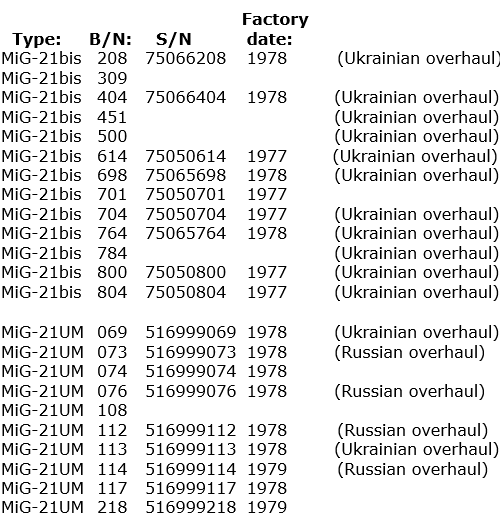
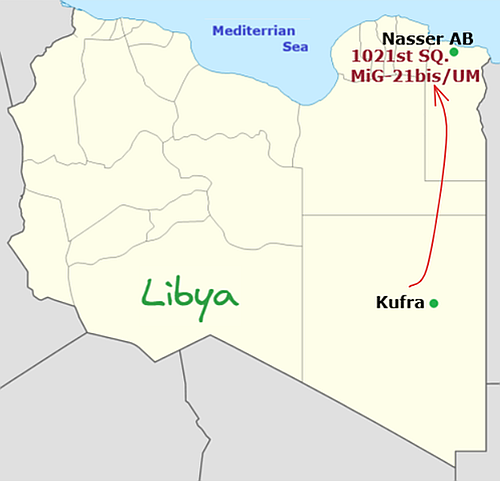
After refurbishment, the Libyan MiG-21s were given Latin tactical numbers. In addition, in 2006, four MiG-21UM ‘Mongol-B’s (B/Ns: 073, 076, 112, 114) that had previously remained in Russia were overhauled for Libya in the 275th Aircraft Maintenance Facility in Krasnodar. The 1021st Air Squadron was re-established in the mid-2000s, equipped with nearly twenty overhauled MiG-21s. Until 2011, they served at Nasser Air Base in the eastern corner of the country, defending the city of Tobruk.
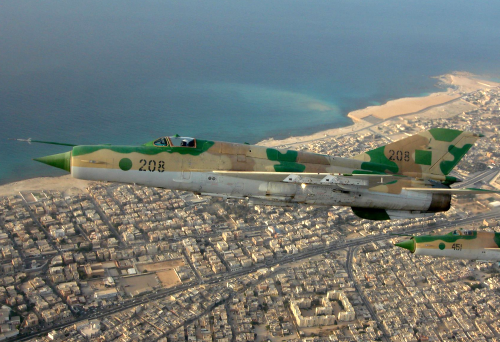
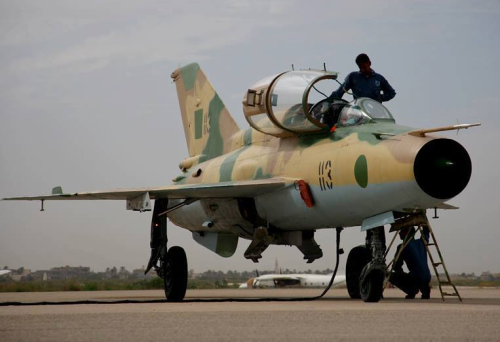
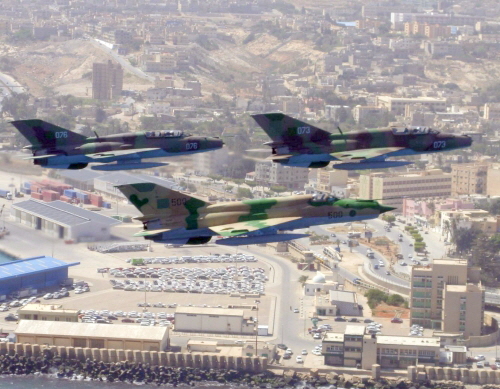
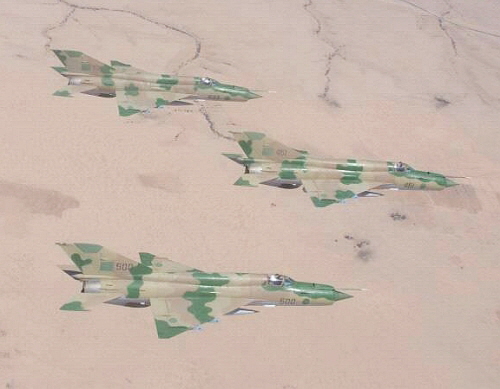
MiG-21bis ‘Fishbed-L’ and MiG-21UM ‘Mongol-B’s of the Libyan Air Force's 1021st Air Squadron in the second half of the 2000s. The lighter (sand-brown-green) paint scheme was done in Ukraine, while the darker (brown-green) paint scheme was done in Russia.
Then, during the civil wars, Libyan MiG-21s fighting and continued to fly until 2022 . What's more the 1021st Air Squadron receiving more new MiG-21 aircrafts, but that's another story.
Sources:
-
Libyan Air Wars: Part 1: 1973-1985 (Africa@War) by Tom Cooper, Albert Grandolini
-
Libyan Air Wars: Part 2: 1985–1986 (Africa@War) by Tom Cooper, Arnaud Delande, Albert Grandolini
-
Libyan Air Wars: Part 3: 1986–1989 (Africa@War) by Tom Cooper, Arnaud Delande, Albert Grandolini
-
And Tijani Alwagaa's researches